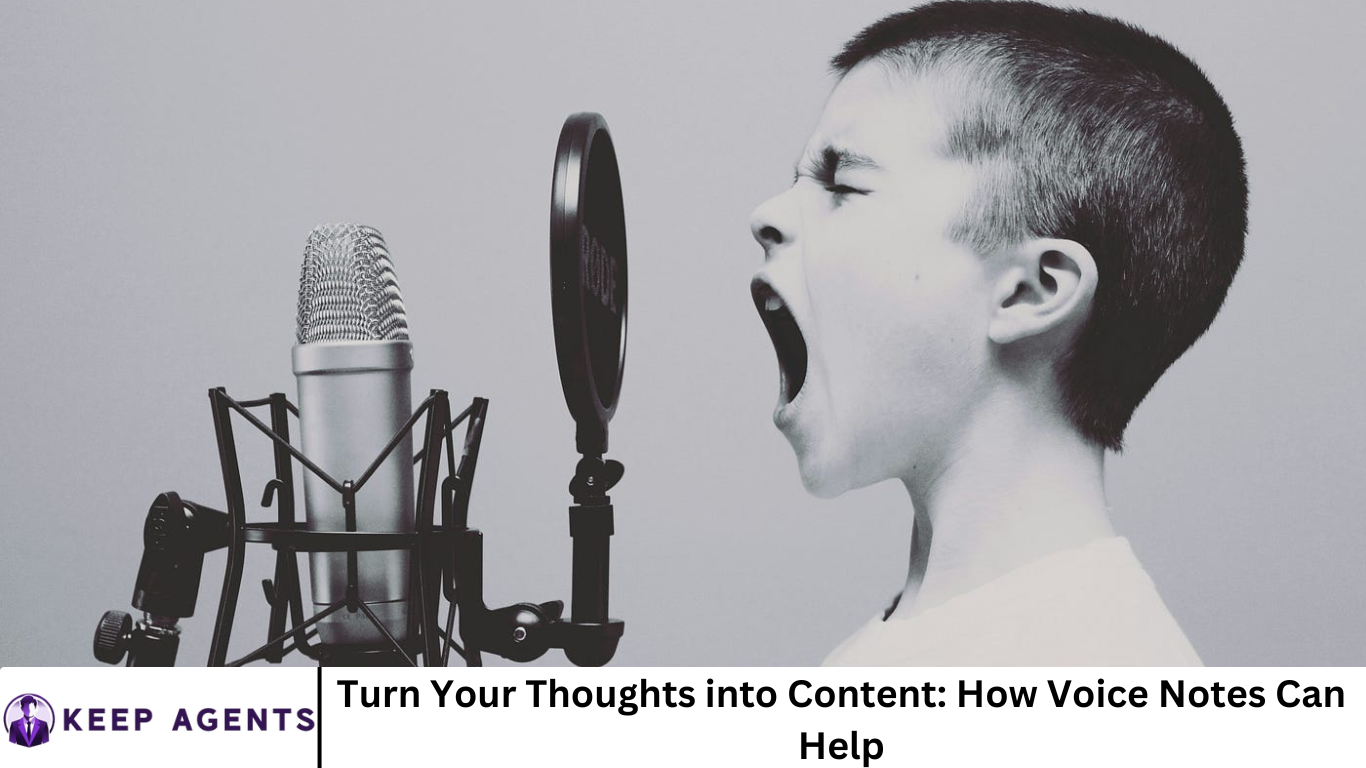Fast-paced digital world, content creators, marketers, entrepreneurs, and busy professionals are constantly brimming with ideas—but capturing those flashes of inspiration before they disappear can be a challenge.
That’s where voice notes come in. Easy to use, always accessible, and surprisingly powerful, voice notes are one of the most underrated tools for turning your thoughts into content.
Whether you’re managing a blog, planning a podcast, outlining a video script, or brainstorming social media posts, this guide will show you how voice notes can become a key part of your content creation workflow. Let’s explore how to capture, organize, and transform your spoken ideas into high-performing content.
More Read: The Ultimate 2025 Guide to Starting a Podcast Step by Step
Why Use Voice Notes for Content Creation?
Voice notes are more than just casual audio memos—they’re a creative lifeline. Here’s why they’re so effective for creators:
1. Capture Ideas Instantly
Ideas don’t follow a schedule. They hit you while you’re commuting, walking the dog, lying in bed, or making dinner. Typing out notes isn’t always feasible, but recording a quick voice memo takes seconds and lets you capture the raw emotion, tone, and flow of your thoughts in real-time.
2. Boost Productivity
Speaking is often faster than typing. If you have an idea for a blog post, podcast topic, or video script, you can record a 2-minute summary instead of spending 20 minutes trying to write it down. Voice notes help you ideate quickly, which makes your content workflow more efficient.
3. Tap into Stream-of-Consciousness Creativity
Voice notes allow for natural, unfiltered thinking. Unlike writing, which can sometimes slow your creativity with over-editing, voice memos promote a free-flowing brainstorming style. This spontaneity often leads to more authentic and engaging content.
4. Hands-Free Convenience
If you’re driving, walking, or multitasking, voice notes allow you to keep the creative flow going without needing to stop what you’re doing. It’s like having a portable brainstorming assistant in your pocket.
Tools for Capturing Voice Notes
There are countless apps and tools that make recording and managing voice notes easy. Here are a few popular ones:
✅ Native Smartphone Apps
- iPhone: Voice Memos (built-in, simple, and syncs with iCloud)
- Android: Google Recorder or native voice recorder apps
✅ Productivity Apps
- Evernote: Attach voice memos to notes and transcribe with AI
- Notion: Embed voice recordings in notes for organization
- Otter.ai: Advanced transcription and search capabilities
✅ Voice-to-Text Tools
- Google Docs Voice Typing
- Apple Dictation
- Dragon NaturallySpeaking
- Descript (ideal for podcasters and video creators)
How to Use Voice Notes in Your Content Creation Workflow
Here’s a step-by-step process to go from spontaneous voice memo to publish-ready content:
Step 1: Capture Ideas as They Come
Keep your phone handy and make it a habit to record thoughts when inspiration strikes. This could be:
- Blog topic ideas
- Social media captions
- Podcast episode themes
- Video outlines
- Email subject lines
- Hooks or opening lines for articles
Pro Tip: Start each note with a clear topic name (e.g., “Instagram Growth Tips” or “Morning Routine Blog Outline”) to make sorting easier later.
Step 2: Organize Your Voice Notes
Once you have a growing library of ideas, organize them by theme or content type:
- Use folders or tags (e.g., Blog Ideas, Social Posts, Scripts)
- Use tools like Notion or Evernote to link voice notes with written notes
- Transcribe your recordings using apps like Otter.ai or Descript
This makes it easier to reference and build out your ideas during your dedicated content creation sessions.
Step 3: Transcribe and Expand
Transcribing your voice notes turns your raw ideas into structured outlines or even first drafts. Here’s how:
- Use AI-powered transcription tools for speed and accuracy.
- Break the transcription into bullet points, headlines, or paragraph ideas.
- Add supporting points, research, or visuals as needed.
What began as a 60-second recording can become the foundation of:
- A 1,500-word blog post
- A YouTube video script
- A podcast episode
- A carousel for Instagram or LinkedIn
Step 4: Edit and Polish
Once transcribed and expanded, polish your content as you normally would:
- Check for clarity, tone, and flow.
- Use grammar tools like Grammarly or Hemingway.
- Add calls-to-action, visuals, or hyperlinks.
Voice notes give you the raw clay—your editing process shapes it into finished content.
Step 5: Repurpose and Reuse
Don’t let your content live in just one place. Voice notes often contain multi-use ideas. For example:
- A blog post idea can become a podcast episode.
- A recorded Instagram caption idea might expand into a LinkedIn post.
- A YouTube script might be turned into an email newsletter.
With voice notes, your content ideation becomes an endless source of material.
Voice Notes for Different Types of Content Creators
🎙️ Podcasters
- Quickly brainstorm episode titles, intros, and transitions
- Record spontaneous commentary or guest questions
- Transcribe voice notes into show notes or marketing content
✍️ Writers & Bloggers
- Dictate article ideas and outlines
- Record thoughts for future deep-dive topics
- Capture emotional tone that can be hard to write
📸 Social Media Creators
- Brainstorm caption hooks and reel scripts
- Plan content themes and series ideas
- Capture insights when scrolling competitors or trends
🎥 Video Creators & YouTubers
- Speak out your video ideas on the go
- Record voice notes as rough takes for scripts
- Capture behind-the-scenes ideas or production notes
Best Practices for Using Voice Notes Effectively
- Be Specific – Name your files clearly: “TikTok Tips – June 2025” is better than “Audio123”.
- Keep It Short – Stick to 1–3 minutes. Quick ideas are easier to review and use later.
- Summarize at the End – Say a quick recap at the end of your memo for clarity.
- Transcribe Regularly – Don’t let a backlog build. Transcribe and sort at least weekly.
- Back Up Your Notes – Use cloud sync (Google Drive, iCloud, Notion) to avoid losing your goldmine of ideas.
Frequently Asked Question
How can voice notes improve my content creation process?
Voice notes allow you to quickly capture ideas in real-time, helping you avoid forgetting great content concepts. They streamline brainstorming, improve productivity, and serve as the first draft for blog posts, videos, podcasts, and social media content.
What are the best apps for recording and organizing voice notes?
Top apps include:
- iPhone Voice Memos (iOS)
- Google Recorder (Android)
- Otter.ai for transcription and search
- Evernote and Notion for organization
- Descript for editing and turning notes into scripts
Can voice notes be turned into written content easily?
Yes! Most voice note apps support transcription, or you can use AI tools like Otter.ai, Descript, or Google Docs Voice Typing to convert recordings into text. These transcriptions can become blog outlines, video scripts, or newsletter drafts.
Are voice notes useful for SEO and keyword research?
Absolutely. When you speak naturally in voice notes, you often use long-tail keyword phrases similar to how people search online. These can be repurposed as SEO-friendly blog titles, headers, or meta descriptions.
How often should I review or organize my voice notes?
Ideally, review and organize your voice notes once a week. Transcribe, label, and sort them into categories like “Blog Ideas,” “Podcast Topics,” or “Social Captions” to keep your content pipeline flowing smoothly.
What if I feel awkward recording myself?
Feeling awkward is normal at first. Start in a quiet, private space and treat it like sending a voice message to a friend. The more you do it, the more natural it becomes—and the creative benefits far outweigh the initial discomfort.
Can voice notes help with content repurposing?
Yes. A single voice note can lead to multiple content pieces—like a blog post, social media quote, podcast segment, or video script. They make it easier to repurpose ideas across platforms, saving you time and boosting consistency.
Conclusion
Voice notes aren’t just a recording tool—they’re a creative amplifier. They help you capture lightning in a bottle and preserve inspiration that might otherwise disappear. Whether you’re a seasoned content creator or just getting started, building a habit around voice memos can supercharge your content pipeline and reduce creative friction. So the next time an idea strikes while you’re mid-walk, mid-shower, or mid-coffee, don’t let it float away. Pull out your phone, hit record, and turn your thoughts into content.


